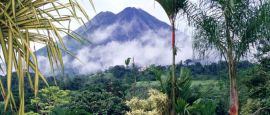Born in the 90s in Costa Rica, canopy ziplining tours offer visitors a chance to glide above tree-tops and enjoy the up-close views of wildlife, including birds and monkeys. Tours are available in several locations, and some of the best places to experience a zipline thrill are Arenal, Braulio Carrillo and Monteverde. For those who prefer a gentler pursuit, try the Treetop Walk in Monteverde.
Costa Rica things to see and do
Costa Ricans like to point out that sustainability isn't just a practice, but a way of life. Apart from preserving some 25% of its natural treasure, the country also produces nearly 93% of its electricity from renewable sources and has various programmes measuring the level of sustainability within the tourism industry.
Covering just 51,100km² (19,730mi²), Costa Rica is a relatively small country, but it is bursting with wildlife at every turn, offering 234.8 plant species, 16.9 bird species and 4.6 mammal species per 1,000km² (386mi²). All in all, it packs nearly half a million species, representing 5% of the earth's biodiversity, within its borders.
Near Turrialba in the Central Valley, Guayabo is Costa Rica's most important archaeological site, populated by indigenous groups between 300 BCE and 1400 AD. The highlights include a 700-year old aqueduct, a stone walkway and several circular mounds said to be supporting conical structures in the past.
Costa Rica's 28 national parks are the country's greatest glory, holding about 5% of the world's biodiversity. Each park offers something unique, from lofty volcanoes to white-sand beaches and extraordinary natural habitats for nearly half a million species. It is comforting to know that the country's natural wonders are never far away.
Aiming to provide an authentic experience, rural tourism allows visitors to discover 'Pura Vida', referring to a simple, peaceful lifestyle that focuses on customs, traditions, and relationships while immersing in the country's natural diversity.
San José, Costa Rica's vibrant capital city, lies in the Central Valley. It has fascinating museums, among them the Pre-Columbian Gold Museum, Jade Museum, and the National Museum are highly revered. Its bustling Central Market (Mercado Central) has over 200 stalls selling everything from cowboy boots to local bounty.
The Caribbean side of Costa Rica stretches from the San Juan River to the Sixaola River along the Panamanian border. The area is blessed with 322km (200mi) of coastline, including the beaches of the Tortuguero National Park, recognised for being the largest nesting ground of green turtles. Nearby, the Barra del Colorado Wildlife Refuge is home to many animals, including sloths, monkeys and crocodiles, while its many rivers and lagoons are known for sportfishing.
Divided into several sections, Costa Rica's Pacific coast is packed with many riches, from must-see natural wonders to arguably the world's most beautiful beaches. Guanacaste, the northern section, is revered for its seaside towns, while the South Pacific coast, specifically its massive Corcovado National Park, is said to be the world's biologically richest place.
As part of the Pacific Ring of Fire, Costa Rica is sprinkled with volcanoes, including five active ones. Volcanoes, most of which and their surrounding areas have been into national parks, attract thousands of visitors each year. For those who are interested, there are three volcanic ranges: the Guanacaste Range in the northwest, the Central Volcanic Range, and the Talamanca Range in the southeast.
Costa Rica has some thrillingly turbulent rivers, where whitewater rafters take the plunge through the rapids. Two of the country's best rivers for rafting are the Reventazón and Pacuare. The latter is where many rafters enjoy a two-day trip in which they camp, swim, and check out toucans, sloths and monkeys in the surrounding rainforest.
Do you have any Feedback about this page?
© 2026 Columbus Travel Media Ltd. All rights reserved. No part of this site may be reproduced without our written permission, click here for information on Columbus Content Solutions.








 You know where
You know where
